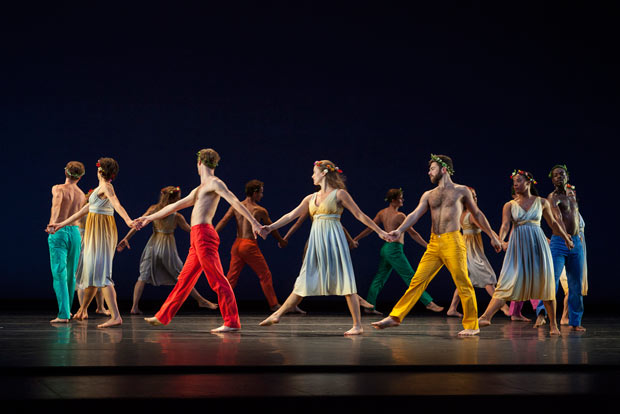
© Ken Friedman. (Click image for larger version)
Mark Morris Dance Group
Program A: Pacific, Words, Whelm, Grand Duo
Program B: Crosswalk, Jenn and Spencer, and Spring, Spring, Spring
New York, Brooklyn Academy of Music
22-23 April 2015
markmorrisdancegroup.org
www.bam.org
A Musical Offering
It’s been a busy few years for Mark Morris and his company. Since 2013, he’s directed a music festival (Ojai), staged a Handel opera (Acis and Galatea) undertaken a tour to Asia under the auspices of the State Department, overseen the filming of his 1988 L’Allegro, il Penseroso ed il Moderato for public television, not to mention the usual busy touring schedule. This summer, the dancers will once again appear at Tanglewood, in a new work set to Bach’s first Brandenburg Concerto (Morris will also conduct at the festival for the first time). He just finished making another new work, with music by Haydn, for the Houston Ballet.
So it’s not surprising that the company hasn’t been at the Brooklyn Academy of Music for a while, three years in fact, though it does feel like too long. The two programs being performed there this week are a survey of new and recent works. Only two date from before 2013. Of these, Grand Duo is a familiar and much-loved piece from 1993. Pacific, though its dates from 1995, is actually new to the company. It was made for San Francisco Ballet, and this is the first time it, or any of Morris’s “ballets”, has been adapted for his dancers. Both Duo and Pacific are set to music by Lou Harrison. The affinity between composer and choreographer is clear: the two share a sense of sweep, an interest in archaic forms, and a kind of stylized “Eastern” influence, as filtered through their own freewheeling, eclectic West Coast imaginations. (Harrison was born in Oregon and raised in California; Mark Morris was born and raised in Seattle.)
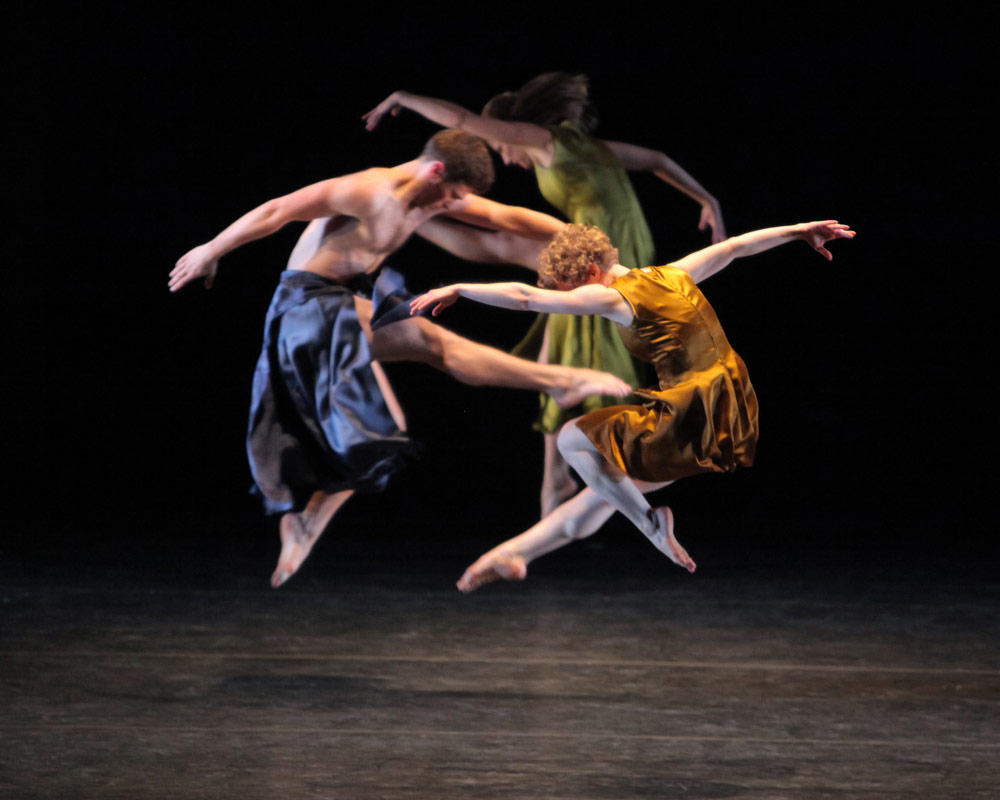
© Erin Baiano. (Click image for larger version)
Crosswalk and Jenn and Spencer are both from 2013; they have been performed in New York before, in the much tighter quarters of the Mark Morris Dance Center studio theatre. Words, made for the Asia tour, premiered at the Fall for Dance festival last autumn; Whelm is brand new. Spring, Spring, Spring, the most complex and ambitious work on either of the two programs, dates from the Rite of Spring centenary, 2013. (Morris swears it was a fluke.)
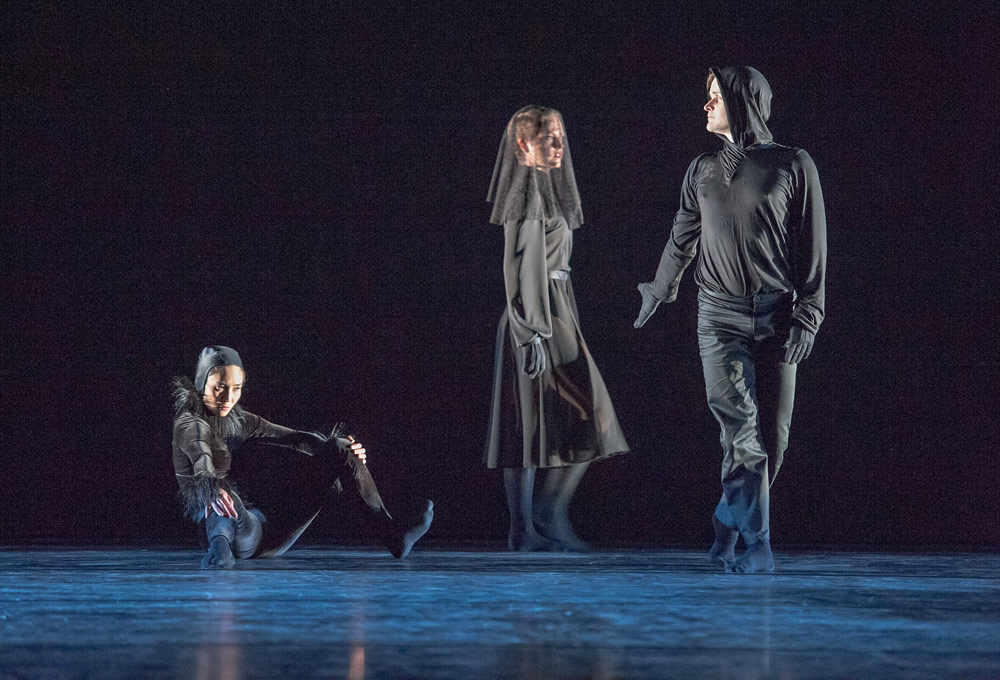
© Stephanie Berger. (Click image for larger version)
As usual, Morris’s musical inclinations underpin the whole enterprise. Everything – the mood, the ideas, the steps, the timing – comes out of the music. But Morris’s response is absolutely personal, and almost always manages to take one by surprise. In Whelm, three Débussy piano works – played resonantly and with great allusive power by Colin Fowler – are the basis of a deeply weird, almost ghoulish ghost story. Four characters, dressed in head-to-toe black (including gloves and head coverings, by Elizabeth Kurtzman), emerge from the darkness like revenants. They walk effortfully, weighed down by bodies that cling to them like shadows or corpses. Later, they slither away like lizards, or skitter around in strange, unnatural shapes. The otherworldly, almost anti-gravitational feel of Débussy’s “Des pas sur la Neige” and “Cathédrale Engloutie” is reminiscent of the Satie Gymnopédies and Gnossiennes used by Frederick Ashton for his Monotones. (The dancers in Monotones also wore gloves and head coverings.) But Ashton’s interplanetary dreaminess has been replaced here by a feeling of uncanny communion with the netherworld. As often happens with Morris, the simplest images are often the most captivating: a woman, veiled in black, walking impassively across the back of the stage, as if trapped in an eternal funeral cortège.

© Elaine Mayson. (Click image for larger version)
Words and Crosswalk, set respectively to music by Mendelssohn and Carl Maria von Weber, evoke lighter moods. Crosswalk, in particular, evokes a kind of playground giddiness, complete with girls skipping hand in hand, dancers tossed fearlessly from group to group, and boys racing each other across a field. That said, it too has its darker recesses, hints of bullying, particularly in the middle movement, where two women (Laurel Lynch and Chelsea Acree) repeatedly push and pull at an unfortunate man (Noah Vinson), shoving him to the ground, dragging him by his legs and generally treating him abominably (as children do). But the cruelties melt into the general cheerfulness of the surrounding activity, just as they do in life. Words is more lyrical, more free. Most of the sections are built upon an interaction between two dancers; two men converse with their hands and arms, a man and a woman reach around each other like snakes or play Simon Says. The interest emerges from the use of contrast: soft and hard gestures, rounded and straight lines, staccato and held movements. It’s all about rhythm and accent. The organizing principle is a device lifted from Indian dance: a curtain, carried by two dancers, partly conceals entrances and exits, creating an element of suspense. Sometimes Morris plays a trick: you see a pair of slender ankles and think there is a woman behind the curtain, and lo and behold, it’s a man; or there are two dancers standing there instead of one.

© Ani Collier. (Click image for larger version)
Morris seems particularly interested in deploying turning and spinning movements these days; turns appear again and again in different forms in many of the new works, especially fast chaînés or dizzying rotations in one spot. Pacific, the ballet created twenty years ago for San Francisco Ballet, also has them, but in this case they mostly consist of classical pirouettes. The dancers wear soft slippers. (It’s almost funny to see Morris’s dancers prepare to turn from the classic, balletic fourth position; we don’t expect it such academic conventions from them.) Pacific is beautiful and spare, grave and grounded, full of well-planted squats and heroic, sculptural arms. It looks good on these dancers, though the partnering in the central pas de deux feels a little bit labored. (Morris’s dancers don’t tend to do so much heavy partnering.) Both the men and the women wear long skirts (designed by the late Martin Pakledinaz), like members of a utopian Pacific island tribe. The men are bare-chested; the women wear plain matching tops. The skirts augment the swinging, bell-like movement of the legs. The dancers’ backs twist and bend; their arms paint clean shapes in the air, completed by the fingers, as sensitive as the bristles on a calligrapher’s paintbrush.

© Hilary Schwab. (Click image for larger version)
Photo Credit: Hilary Schwab
Precision and clarity of intention are two of Morris’s most defining qualities. One never gets the sense that the choreographer was at a loss or groping his way through the music, or even skimming its surface. There’s not much room for ambiguity, which is one of the things that people who don’t like his dances are bothered by. This tendency is particularly evident in his interpretation of The Right of Spring, entitled Spring, Spring, Spring after a song in the movie Seven Brides for Seven Brothers. It’s an entirely, almost obsessively lucid reading of the music, underscored by The Jazz Plus’s hyper-articulate re-orchestration for jazz trio (piano, percussion, bass), performed in the pit. In The Jazz Plus’s interpretation, one hears every detail in the score, scrubbed and polished. The dancers, too, function almost like notes on a page. The choreography has the feeling of higher math, using complicated counting sequences, rendered with absolute intelligibility. There is no room for error. At one point, the dancers move like parts of a loom, arms rising and falling, wrists crossing, backs rocking forward and back. I saw a dancer momentarily lose track of one of the counts; the machine went haywire, then snapped back into gear. It was hard not to sympathize. The dance is a marvel of construction, peppered with gorgeous moments – swishing arms and buoyant jogs, crisp lines that morph into beautiful circles and back again. But at the same time it feels weirdly lacking in joy or sensual pleasure. It denotes Bacchanalian revelry but doesn’t embody it or evoke it in the audience. Nor does it get at the music’s raw power. The most suggestive, moment, in fact, takes place before the dance even begins: the lights go down and the audience is left to listen to a scratchy recording of Stravinsky’s opening phrases. As amphibious sounds emerge from the murky slumber of prehistoric time, one marvels once again at the wildness of Stravinsky’s imagination.
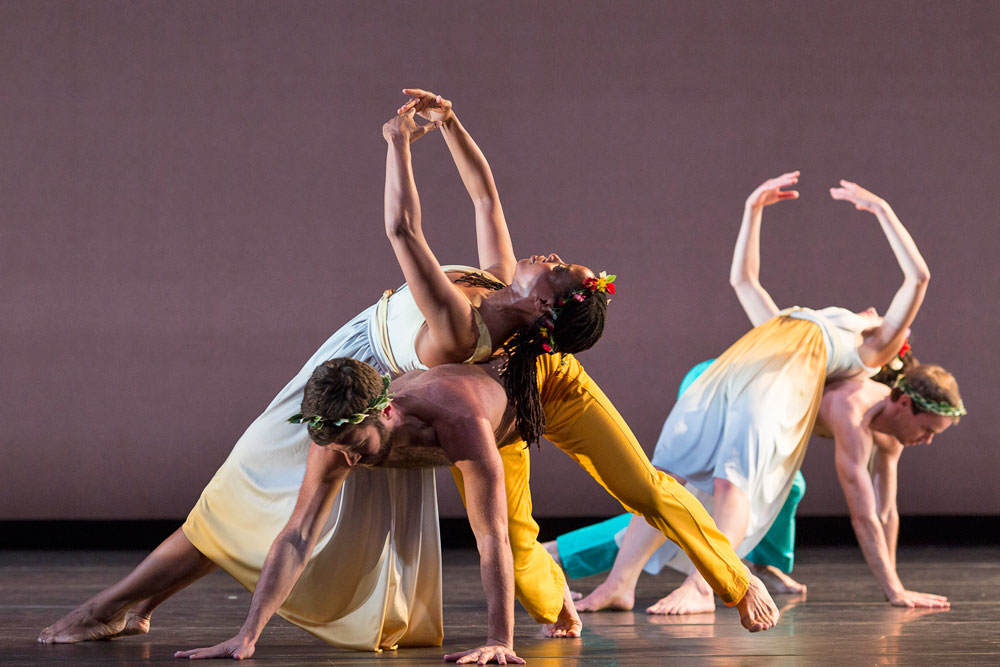
© Ken Friedman. (Click image for larger version)
The lack of affect of Morris’s Rite lies at the furthest remove from the harrowing anger that suffuses his Jenn and Spencer, a male-female duet with which it shares a program. If there ever was a more visceral dance, one more damning of male-female relations – the neediness and aggression that bind people together and drive them to mutual destruction – I have yet to see it. Here, as in every piece, the dancers made every movement, rhythmic shift, and accent count. (The unrelenting Jenn Weddel, for whom the dance was created, was paired here with Sam Black, who gives the impression of a decent man dragged into the mire against his better nature.) I was particularly struck, in general, by the fullness with which all the dancers use their backs. And by the individual qualities they bring to the movement: Laurel Lynch’s monumental grace, like a Greek statue come to life; Aaron Loux’s economy of movement, and the twist in his shoulders; Domingo Estrada’s full-throttle, but un-emphatic, sense of attack; Billy Smith’s quiet lyricism. And yet, for all their individual qualities, they move with a singularity of purpose, a unity of intention that is particular to this company. Self-indulgence has been stripped away. What you get is the idea itself, the steps, as they were imagined; and through them, the music.












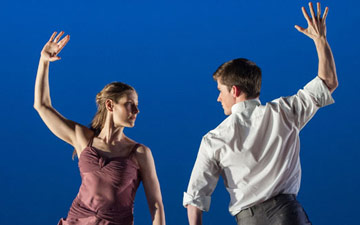

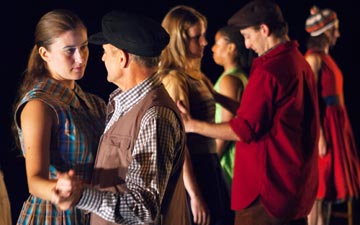
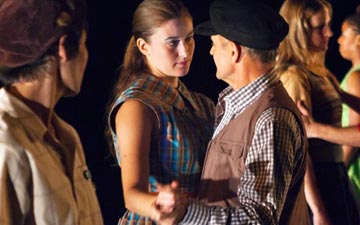
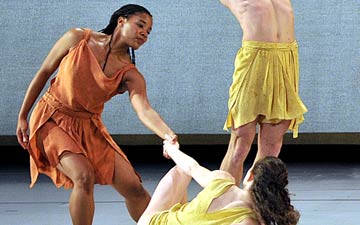
You must be logged in to post a comment.